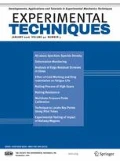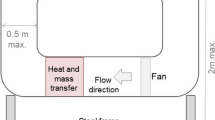Abstract
The simulation of wind-driven rain in the wind tunnel should ensure a realistic representation of rainfall events in a laboratory environment. It necessitates therefore an understanding of how the governing input parameters of the tunnel relate to its outputs. In this perspective, a preliminary calibration should be carried out in order to grant the reproduction of a homogeneous volume of rainwater and a natural raindrop size distribution. A precise and straightforward procedure to be followed is missing. Based on experimental investigations, this study outlines a series of calibration steps that should be performed in the wind tunnel before the rain simulation takes place. It applies in particular to small scale facilities as opposed to the large wind tunnels designed for full-scale testing of building components and vehicles. Such procedure concentrates on the following aspects: wind speed calibration by vane anemometer; calibration of the sprinkler system and rain intensity measurements for assessing its spatial distribution. The main findings include the introduction of a governing function for the sprinkler system, a method for rain mapping as well as the individuation of an optimal set-up in the wind tunnel for rain simulation.





















Similar content being viewed by others
References
Flower JW, Lawson TV (1972) On the laboratory representation of rain impingement on buildings. Atmos Environ 6:55–60
Rayment R, Hilton M (1977) The use of bubbles in a wind tunnel for flow-visualisation and the possible representation of raindrops. J Wind Eng Ind Aerodyn 2:149–157
Aaron KM, Hernan M, Parikh P, Sarohia V (1986) Simulation and analysis of natural rain in a wind tunnel via digital image processing techniques. AIAA PAPER 86-0291, AlAA 24th aerospace sciences meeting January 6–9, Reno, Nevada, USA
Surry D, Inculet DR, Skerlj PF, Lin J-X, Davenport AG (1994) Wind rain and the building envelope: a status report of ongoing research at the University of Western Ontario. J Wind Eng Ind Aerodyn 53:19–36
Inculet D, Surry D (1994): Simulation of wind-driven rain and wetting patterns on buildings. BLWTLSS30-1994, Final report, Canada Mortgage and Housing Corporation,Ottawa Ontario
Inculet DR (2001) The design of cladding against wind-driven rain. Ph.D. thesis, the University of Western Ontario, London, Canada
Lopez C, Masters FJ, Bolton S (2011) Water penetration resistance of residential window and wall systems subjected to steady and unsteady wind loading. Build Environ 46:1329–1342
Bitsuamlak GT, Chowdhury AG, Sambare D (2009) Application of a full-scale testing facility for assessing wind-driven-rain intrusion. Build Environ 44:2430–2441
Knasiak, K., Schick, R. J., Kalata, W. (2007): Multiscale design of rain simulator. 20th Annual Conference on Liquid Atomization and Spray Systems, May 15–18, Chicago, IL, USA
Blocken, B., Van Mook, F. J. R., Höberg, A. (1999): Full-scale driving rain simulation in the Jules Verne Climatic Wind Tunnel. Training and mobility of researchers, access to largescale facilities-access for researchers. Research Proposal. http://fabien.galerio.org/drivingrain/nantes/nantes.html. Accessed 10 July 2017
Gandemer J (2001) Final report: large scale facilities, Jules Verne climatic wind tunnel. Contract ERB 4062PL970118
Baheru T (2014) Development of test-based wind-driven rain intrusion model for hurricane-induced building interior and contents damage. FIU electronic theses and dissertations, paper 1127. https://digitalcommons.fiu.edu/etd/1127. Accessed 10 July 2017
Blocken B, Abuku M, Roels S, Carmeliet J (2009) Wind-driven rain on building facades: some perspectives. EACWE 5, July 19–23, Florence, Italy
Baheru T, Gan Chowdhury A, Bitsuamlak G, Masters FJ, Tokay A (2014) Simulation of wind-driven rain associated with tropical storms and hurricanes using the 12-fan wall of wind. Build Environ 76:18–29
Testo.com (2013) VAC analysis measuring instrument testo 480- Cutting-edge technology for professionals. http://www.testolimited.com/testo-480-high-end-vac-measuring-instrument. Accessed 10 July 2017
Spraying systems Co. (2017) Section B – full cone spray nozzles. http://www.spray.com/spray_nozzles/full_cone_fulljet_nozzles.aspx. Accessed 10 July 2017
Fiedler-Magr (2017) TS-200, TS-314, TS-500 Varovné srážkomìrné stanice v síti GSM. https://www.fiedler.company/cs/produkty/snimace-cidla-senzory/destove-srazky/srazkomerne-stanice. Accessed 10 July 2017
Thies (2011) Laser precipitation monitor-instruction for use. http://www.biral.com/product/laser-precipitation-monitor/. Accessed 10 July 2017
Thies (2011) PC - Program LNM Vie w 9.1700.99.000 from version 2.5- Instruction for use. http://www.biral.com/product/laser-precipitation-monitor/. Accessed 10 July 2017
Dingle AN, Lee Y (1972) Terminal fall speeds of raindrops. J Appl Meteorol 11:877–879
Best AC (1950) The size distribution of raindrops. Q J R Meteorol Soc 76:16–36
Lacy RE (1964) Driving rain at Garston, UK. CIB Bull 4:6–9
Straube J (1998) Moisture control and enclosure control systems. Ph.D. thesis, the University of Waterloo, Waterloo
Lora M, Camporese M, Salandin P (2016) Design and performance of a nozzle-type rainfall simulator for landslide triggering experiments. CATENA 140:77–89
Carvalho CPS, de Lima JLMP, de Lima MIP (2014) Using meshes to change the characteristics of simulated rainfall produced by spray nozzles. Intern Soil Water Conserv Res 2:67–78
Acknowledgements
This research was financially supported by the project TAČR EPSILON TH02010324 of the Technology Agency of the Czech Republic and CET sustainability project LO1219 (SaDeCET) of the Ministry of Education Youth and Sport of the Czech Republic.
Author information
Authors and Affiliations
Corresponding author
Rights and permissions
About this article
Cite this article
Cacciotti, R., Pospíšil, S., Kuznetsov, S. et al. A Proposed Calibration Procedure for the Simulation of Wind-Driven Rain in Small-Scale Wind Tunnel. Exp Tech 43, 369–384 (2019). https://doi.org/10.1007/s40799-018-0290-x
Received:
Accepted:
Published:
Issue Date:
DOI: https://doi.org/10.1007/s40799-018-0290-x



